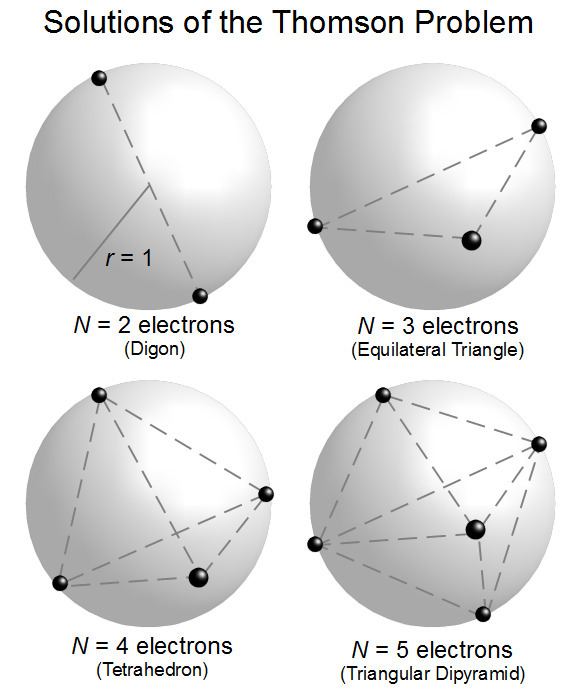 | ||
The objective of the Thomson problem is to determine the minimum electrostatic potential energy configuration of N electrons constrained to the surface of a unit sphere that repel each other with a force given by Coulomb's law. The physicist J. J. Thomson posed the problem in 1904 after proposing an atomic model, later called the plum pudding model, based on his knowledge of the existence of negatively charged electrons within neutrally-charged atoms.
Contents
- Mathematical statement
- Example
- Known solutions
- Generalizations
- Relations to other scientific problems
- Configurations of smallest known energy
- References
Related problems include the study of the geometry of the minimum energy configuration and the study of the large N behavior of the minimum energy.
Mathematical statement
The physical system embodied by the Thomson problem is a special case of one of eighteen unsolved mathematics problems proposed by the mathematician Steve Smale — "Distribution of points on the 2-sphere". The solution of each N-electron problem is obtained when the N-electron configuration constrained to the surface of a sphere of unit radius,
The electrostatic interaction energy occurring between each pair of electrons of equal charges (
Here,
Simplified units of
The total electrostatic potential energy of each N-electron configuration may then be expressed as the sum of all pair-wise interactions
The global minimization of
Example
The solution of the Thomson problem for two electrons is obtained when both electrons are as far apart as possible on opposite sides of the origin,
Known solutions
Minimum energy configurations have been rigorously identified in only a handful of cases.
Notably, the geometric solutions of the Thomson problem for N = 4, 6, and 12 electrons are known as Platonic solids whose faces are all congruent equilateral triangles. Numerical solutions for N=8 and 20 are not the regular convex polyhedral configurations of the remaining two Platonic solids, whose faces are square and pentagonal, respectively.
Generalizations
One can also ask for ground states of particles interacting with arbitrary potentials. To be mathematically precise, let f be a decreasing real-valued function, and define the energy functional
Traditionally, one considers
One may also consider configurations of N points on a sphere of higher dimension. See spherical design.
Relations to other scientific problems
The Thomson problem is a natural consequence of Thomson's plum pudding model in the absence of its uniform positive background charge.
Though experimental evidence led to the abandonment of Thomson's plum pudding model as a complete atomic model, irregularities observed in numerical energy solutions of the Thomson problem have been found to correspond with electron shell-filling in naturally occurring atoms throughout the periodic table of elements.
The Thomson problem also plays a role in the study of other physical models including multi-electron bubbles and the surface ordering of liquid metal drops confined in Paul traps.
The generalized Thomson problem arises, for example, in determining the arrangements of the protein subunits which comprise the shells of spherical viruses. The "particles" in this application are clusters of protein subunits arranged on a shell. Other realizations include regular arrangements of colloid particles in colloidosomes, proposed for encapsulation of active ingredients such as drugs, nutrients or living cells, fullerene patterns of carbon atoms, and VSEPR Theory. An example with long-range logarithmic interactions is provided by the Abrikosov vortices which would form at low temperatures in a superconducting metal shell with a large monopole at the center.
Configurations of smallest known energy
In the following table
It is customary to also consider the polyhedron formed by the convex hull of the points. Thus,
According to a conjecture, if
